Menu
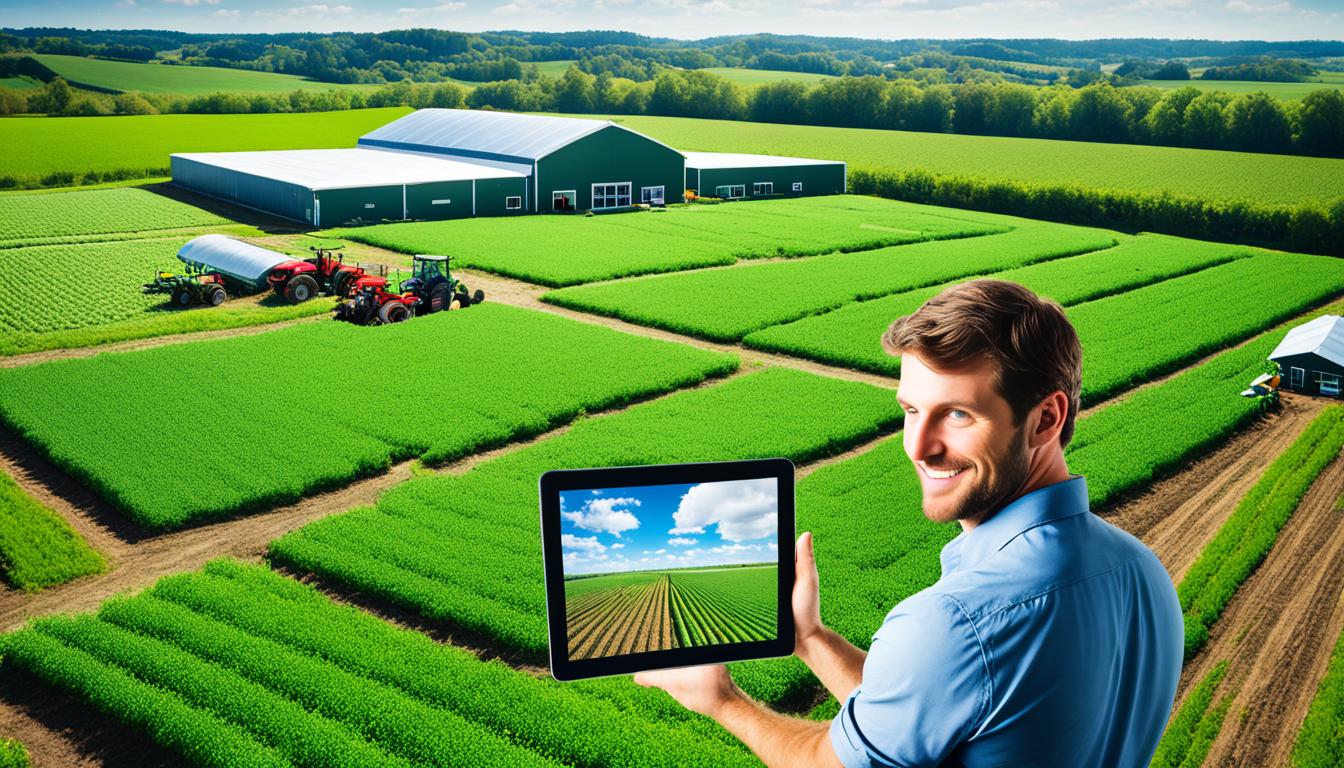
Farm management platforms offer workflow automation to make the farm work smoother. They are becoming key in modern farming. By using digital technology and farm automation, these platforms help make better decisions and increase farm productivity.
The WEZOM team has created remote monitoring solutions. These are changing how farms keep an eye on their resources. With IoT, it’s possible to watch over everything in real time. This keeps the farm running without stops, which is great for productivity.
These solutions also include many useful features. For example, monitoring crops, instant support when needed, keeping track of supplies, and planning the farm’s layout. Tools for tracking animals, watching water use, checking rainfall, and getting alerts for fences help farmers run their operations more effectively.
Farm management applications do a lot, like Maps, Task Management, and Planning. Farms like Stoney Creek, Red Hill, and Llanelli Farm in Australia show what these apps can do. They save a lot of time, help track animals better, manage water smarter, and solve problems quickly.
Remote farm management solutions are changing how we deal with farming today. They use high-tech tools to suit each farm’s needs. These include tools like satellite images, precise farming, and online advice, all aimed at working better together.
The heart of remote farm management is using new tech. Adding IoT in agriculture helps make work smoother with real-time checks and automatic systems. For example, data analysis helps check water and sunlight quality early, while sensors and AI sort fruits by ripeness. And now, having apps in farm software means farmers can check and change things wherever they are.
Using remote farm tools is crucial now. It simplifies work, making farms more efficient. Statista said smart farming could hit a $27 billion market by 2020, showing its importance. Farm software does many tasks like tracking assets and managing work time and people. These abilities help farms make better choices and use resources well, leading to more productivity.
Remote farm management enhances agricultural operations in many ways. It boosts efficiency, increases productivity, and cuts down on costs. Through remote crop monitoring and advanced IoT devices, farmers improve their farm planning and everyday management.
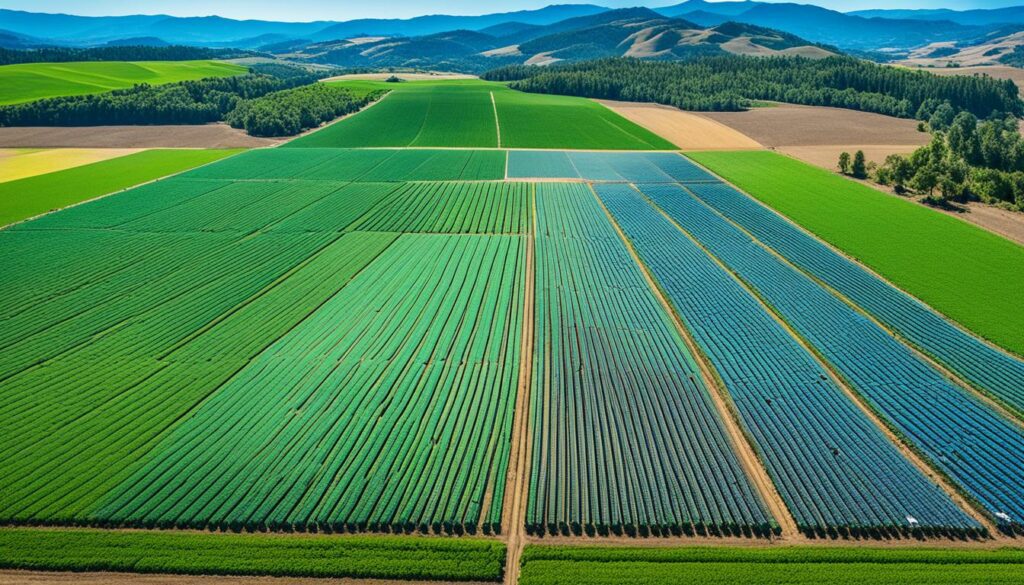
Remote sensing tech, like satellites and drones, boosts farm efficiency. Combining satellite data and on-site info gives an in-depth look at farm activities. This helps farmers make wiser decisions. It also allows for precise farming methods, increasing productivity.
AI and digital processing are pushing remote farm management into the future. Tools like satellite images and weather data provide real-time insights. These help in detecting crop issues early and using resources wisely, leading to better yields.
Remote farm management is great for saving money. Using farm software helps in managing stock better, which cuts down on losses. It also helps to see which crops and fields are making the most profit. This way, unnecessary spending can be avoided.
Remote monitoring tools are crucial for environmental care and efficient farm planning. They’re especially helpful for small and medium-sized farms. These tools help in using less input and still being productive, thus saving costs.
Farm management software is key for following rules and getting traceable data. It also supports better decisions, improving how we do farming and manage farms.
Remote farm management is all about thinking ahead. It uses technology for smarter planning, leading to farming that is both eco-friendly and cost-efficient.
Technology is changing farming, making it more efficient and sustainable. Now, farmers use the Internet of Things (IoT) for precision in farming and to monitor livestock. With these tools, farmers can make better decisions using data. This improves how much they produce and saves resources.
IoT is making farming better by watching over fields and animals closely. It’s all about collecting smart data quickly. For example, sensors help with when to water and check crops after they’re picked to use everything well. Drones are also being used to spray crops and find weeds. This makes farming much more accurate.
Digital tools are changing how farmers work. They can plan and watch over their farms better thanks to IoT sensors and smart software. This way of working boosts how good the farm is and its productivity. And now, keeping track of an animal’s health from far away is possible too. This means animals are looked after better. There’s software for managing fields and crops too, which makes farm tasks easier. It also helps keep track of laws and farm records, saving time and money.
By 2018, $6.7 billion had been invested in these technologies. The world of greenhouses alone makes $350 million each year thanks to these advances. They’ve shown everyone how much can be produced in a smarter way. With the world’s population set to grow by 3 billion by 2050, using these high-tech solutions in farming is key.
| Technology | Application | Benefits |
|---|---|---|
| IoT Sensors | Irrigation Management, Post-Harvest Monitoring | Optimal Resource Utilisation |
| Drones | Crop Spraying, Weed Identification | Enhanced Precision Farming |
| Farm Management Software | Crop Planning, Field Mapping | Streamlined Operations, Improved Budget Management |
| Remote Health Monitoring | Animal Health And Welfare Tracking | Enhanced Livestock Monitoring |
Precision farming changes the game in agriculture by using high-tech analytics and smart farming tools. This approach gets the most out of every resource. That means big increases in productivity and money for farmers.
Precision farming uses the latest in data crunching and IoT. It places seeds carefully and maps fields for perfect crop growth. Thanks to smart farming gizmos, farmers can boost their crops, cut costs, and look after the planet, too.
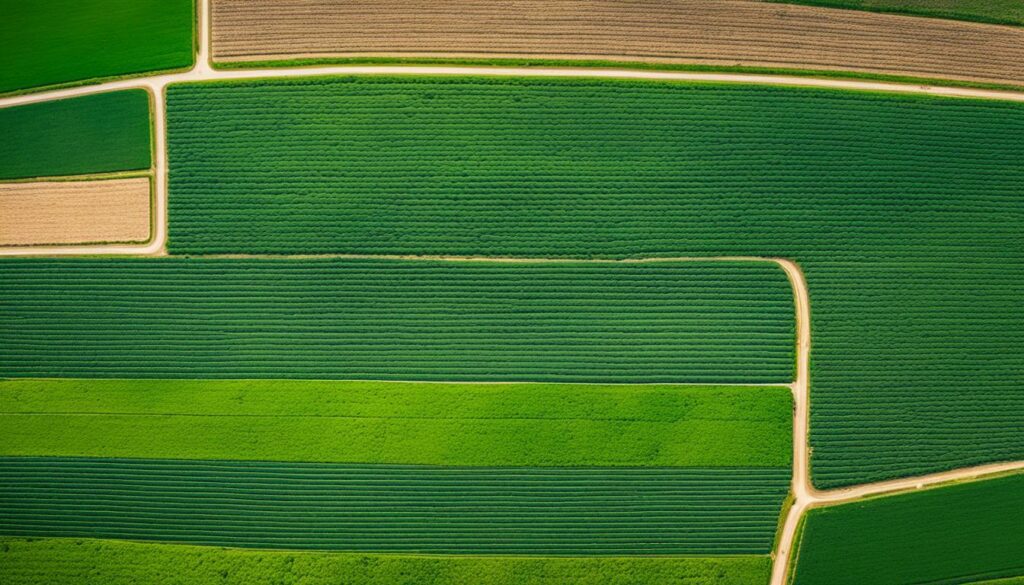
There are many advanced gadgets and methods in precision farming. Giants like John Deere have tools to watch over farms and make them better. The John Deere Operations Center™ helps farmers manage their data easily.
Real-Time Kinematic (RTK) tech is a game-changer, too. It offers super precise farming tasks and turns long jobs into quick ones. This shows how using precise technology speeds up and improves farming.
Important numbers show just how much precision agriculture can do:
| Benefit | Percentage Improvement |
|---|---|
| Production Increase | 4% |
| Fertiliser Use Reduction | 7% |
| Herbicide Application Decrease | 9% |
| Fossil Fuel Decrease | 6% |
| Water Usage Savings | 4% |
Precision farming boosts productivity and helps the environment. It allows for farming that is both efficient and eco-friendly. This preserves the land for years to come.
Global agriculture is changing fast. It now relies heavily on advanced farm management software. Farms use these tools to make work easier, boost productivity, and help farmers worldwide.
Good farm management software has key features every farm needs. A big one is automation. This reduces the work you have to do by hand and makes better use of your resources.
Managing equipment is also vital. It keeps your machines running well, so they last longer and have less downtime. Another must-have is strong technical support. It makes sure you can get help when you need it and keeps your software running smoothly.
Finding the best software for your farm might seem hard with so many choices. But, it’s crucial to pick one that fits your farm’s needs, like the crops you grow and how big your operation is.
The perfect software should help you plan and manage your finances. This is key for tracking costs and keeping your farm profitable. Also, considering cloud-based software, which is very popular nowadays, will let you work from anywhere. This is great for keeping your farm running smoothly and making the best decisions.
With the farm software market booming, it’s clear these tools are essential. By 2032, they’re expected to hit a revenue of USD 8.94 billion. So, using farm software is crucial for growing and improving efficiency.
More farmers are seeing the benefits, with 63% already using farm software. This shift towards technology means farms of the future will be smart and data-driven. With the right software, making decisions based on information will be easier than ever. This is where farm management platforms really shine.
Remote crop monitoring is vital in today’s farming. It lets farmers use high-tech tools to watch over their crops better. By using drones and satellite images, farmers can keep an eye on large areas closely.
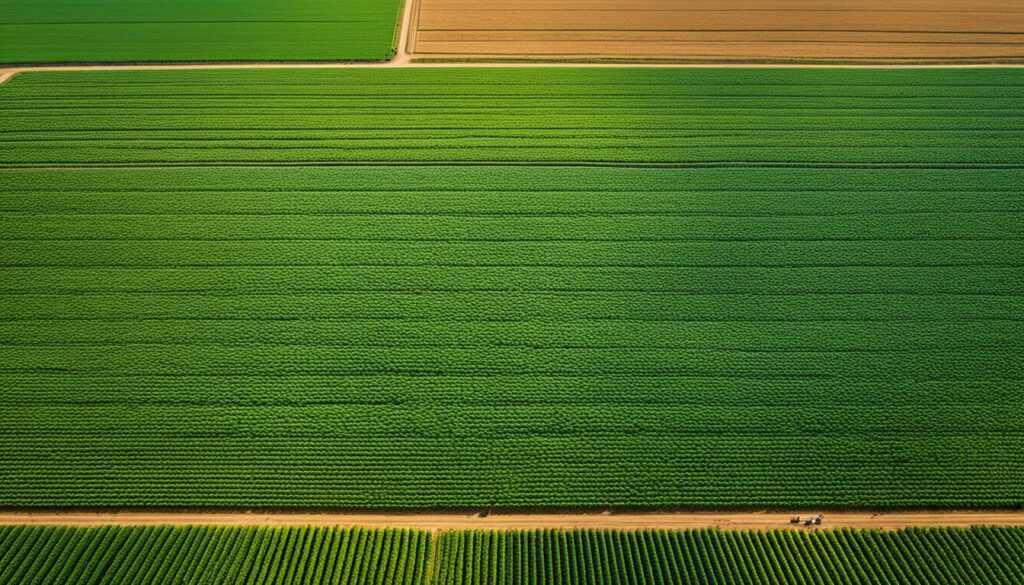
Drones and satellites have changed how farmers look after their crops from a distance. Drones can go up close to inspect crops and take detailed pictures. On the other hand, satellites provide a view from above, looking at big areas and keeping track of the weather and crop conditions.
This combination gives a farming team a full view, even in the furthest fields.
Real-time data is key in keeping crops healthy. Sensors in the fields pick up on things like soil moisture, temperature, and nutrient levels. They send this info to a main computer for analysis.
Special computer programmes check this data for any warnings, like moisture levels being too low. These warnings can help farmers act fast to avoid crop damage.
The goal of using smart tech on crops is to use resources better, boost crop amounts, and save money. As farming tech gets smarter, it will use things like artificial intelligence to get even better. This means crops can be taken care of with more accuracy and efficiency.
| Technology | Benefits |
|---|---|
| Drones | High-Resolution Visual Inspection, Phenological Observations |
| Satellite Imagery | Large-Scale Analysis, Frequent Updates |
| Wireless Sensors | Real-Time Data Collection, Ease of Deployment |
Groundbreaking methods in livestock monitoring are changing the game for farmers. Companies like Ag Drones are leading the charge. They bring advanced technology to farming, making animal health monitoring a breeze.
Keep tabs on your livestock with Ag Drones’ innovative tech. Farmers can watch over their animals from afar. This gives insights into their health, breeding, and eating habits. Ag Drones’ radio-telemetry stands out, offering detailed info with ease.
Their use of AI spots health issues early. It’s a big help in stopping disease and keeping animals healthy. Plus, their drones can see in the dark. This means they can track all sorts of animals, even the hidden ones, helping with their health check-ups.
Ag Drones offers a solution that facilitates the rapid location of animals and provides lifetime traceability through discreet, hard-to-remove tags.
Managing what your animals eat and drink is key to successful farming. Thanks to AI, farmers can check their animals’ food and water habits closely. This can spot health problems early. Plus, Vision AI helps figure out the best times for them to eat or graze.
Ag Drones is also great at training drone pilots. These skills can help farmers look after their animals on big or hard-to-reach lands. This keeps their livestock safe and happy.
| Technology | Benefits |
|---|---|
| Ag Drones | Real-time tracking, animal welfare monitoring, lifetime traceability |
| AI Models | Disease probability detection, swift intervention, feeding pattern monitoring |
| Vision AI | Feed and water management, optimised grazing, early disease detection |
| Thermal Imaging | Spot nocturnal animals, assist in population monitoring |
Farm automation is attracting more interest in modern agriculture. It’s seen as a way to improve efficiency and lower the need for manual work. This is especially crucial as the world’s population is expected to hit 9.7 billion by 2050 and food production must go up by 70%.
Smartphone-controlled systems for tasks like irrigation have become popular. They simplify complex jobs and are not too expensive. Mushroom farmers, dealing with a 20% work shortage, often see £200 million in wasted crops. Yet, with automated pickers, their yields have increased by 10%, showing the clear benefits.
The use of machines like autonomous tractors is picking up. They aren’t just efficient; they’re also eco-friendly. Robots, for example, can slash pesticide use by 90% with their smart vision.
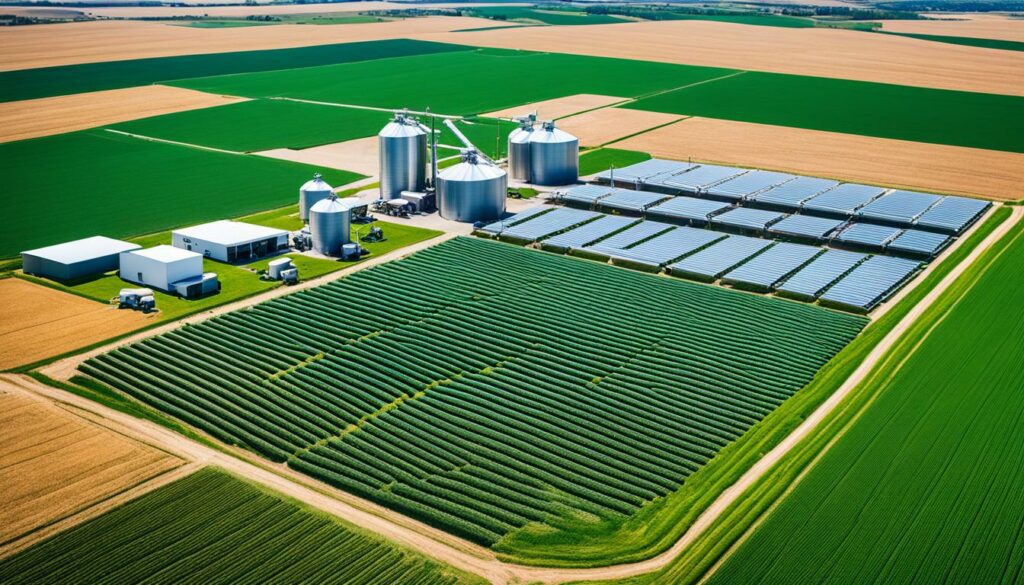
Getting funds for these innovations is easier thanks to loans designed for farms. These options allow farmers to buy modern equipment, using their land as security. By 2050, it’s estimated that the amount of data collected from farms will jump significantly, from 190,000 to 4.1 million, offering vast amounts of insight for better farming.
It’s important to embrace these farm automation technologies. They’re key to overcoming today’s farming challenges and ensuring growth is sustainable. The goal is to make these innovations affordable and obtainable, for a profitable and green future in agriculture.
Satellite imagery changes how we manage farms remotely. It shows us crop health and predictions for their yield. This technology lets us closely watch over the farm, which helps in making smart choices.
Using satellite images on farms has big benefits. It can spot weeds, pests, water problems, and weather damage early. Catching these issues soon helps to save money and keep crops healthy.
It can also find areas with less plant life and measure the harm in various spots. This helps farmers and investors to use past data and current checks for making wise decisions.
Also, satellite data helps with precision farming. This means making the right choices, like using the best amount of fertiliser, or water, in each area.
To use satellite images, you’ll need special software. This software reads the data and can suggest different treatments or check the yield accurately.
For a good system, mix this tech with local checks. This makes sure you get the right info for managing the farm well.
Using databases from big sources and adding your ground checks gives a complete picture. This improves the way you manage the farm.
New technologies make satellite imaging even better. These let us see the farm in more detail and every day. They’re a key tool for modern farming.
In the end, satellite images help us farm more precisely and sustainably. By using such advanced tools, farmers can better manage their resources. This leads to greener agriculture.
Good water management and irrigation automation are crucial in modern farming. Smart irrigation systems let farmers use water better, cutting down on waste. This boosts their productivity, marking a major leap in farming efficiency.
Smart irrigation systems are key for better farming. They use remote control and real-time checks to save water. Farmers with FMS automated systems save a lot on water, time, and other costs. The FMS also boosts crop yield and profits by managing water better.
The FMS stands out with its LoRaWan tech, offering long-distance wireless for farms. This tech works well over long ranges and even through obstacles. So, farmers get good coverage and management across all their land.
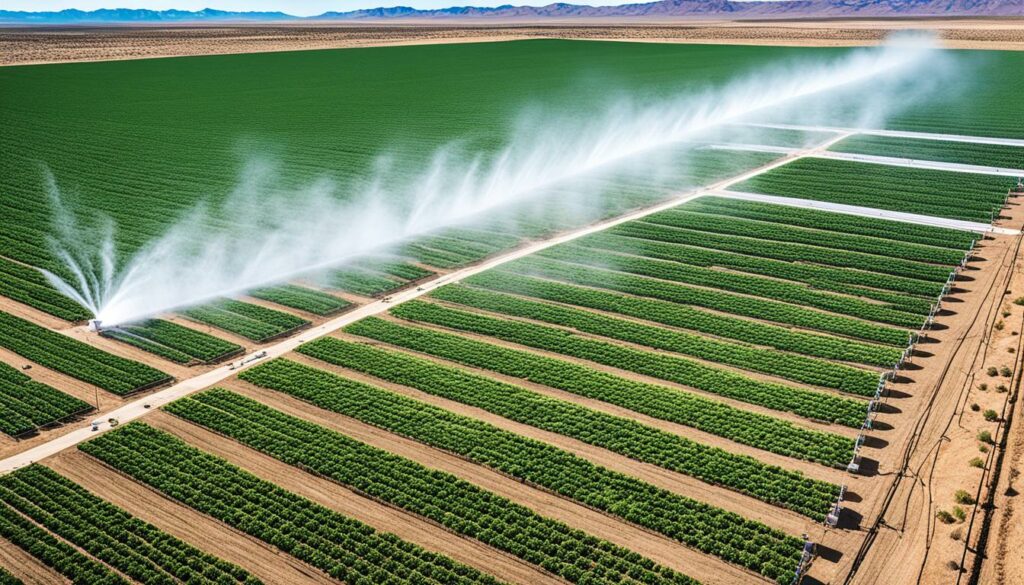
The FMS also has variable speed drives that save up to 50% on energy. These drives let farmers change their watering plans easily. Plus, they can check and control watering from their phones or computers.
Stopping water waste is very important in farming. The FMS helps by showing irrigation settings in real-time. This lets farmers make quick, smart changes that save water and fit crops’ needs.
Using the FMS means farm productivity goes up. It takes better care of livestock and improves farm health. The FMS can work with many different farming setups, making it very versatile.
Farmers love how the FMS saves them time and money. The easy remote control is a big plus. The FMS can fit with most existing irrigation systems, avoiding extra costs for farmers.
| Metric | Traditional Irrigation | FMS Automation |
|---|---|---|
| Water Usage | High | Optimised |
| Energy Costs | High | Reduced by up to 50% |
| Labour | Intensive | Minimised |
| Yield | Standard | Increased |
Using smart irrigation and managing water better boosts farms. With these new techs, farmers can use water well, cut waste, and work more efficiently.
Looking at how digital agriculture is put into practice helps us see its real power. We’ll look at some case studies showing the big changes digital consulting and smart crop planning can make.
DA Hall & Co, which mainly produces eggs, faced a big problem with staying connected. Their farms in the Millmerran region were too far for good AI and big data use. But, they got help from Internet Innovations. They improved the mobile network and made the 4G more reliable.
These solutions increased real-time data across the sheds. This led to better bird health and more productivity. It also made things safer, improved health, and made the business work better. To know more, check out these detailed studies.
Another farm got better at managing livestock through technology. This let them monitor things like feeding and water live. They could also keep an eye on the animals’ health. These digital tools not only made the animals’ lives better. They also used resources smarter, showing how tech can boost farm success. For more stories like this, see these case studies.
From these stories, it’s clear that knowing what you want from AgTech is key. Whether it’s saving labour, using big data better, or making decisions smarter, having a clear goal is vital for success.
Today, agriculture is changing fast. New technology and digital trends are leading the way. Looking forward, key trends and challenges will define farming’s future.
Digital twins technology will change farming. It was worth $6.9 billion in 2022 and is set to hit $73.5 billion by 2027. This tech lets farmers make virtual copies of their farms. It helps them better watch and manage their operations. Virtual and augmented reality are also set to boost farming. They will help with training, vet care, and keeping animals safe.
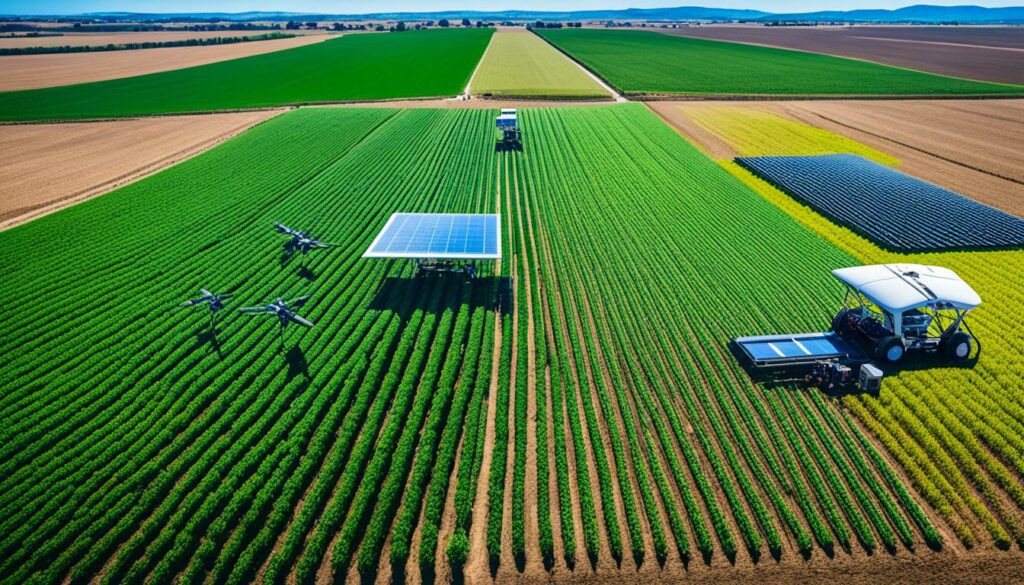
Making broadband reach rural areas is essential. In places like Pennsylvania, 13% of rural folks don’t have it. The FCC’s $20.4 billion fund will help fix this. Groups like the Penn State Extension are also chipping in. They’ve helped get nearly $369 million for better internet in Pennsylvania. Thirteen internet providers are now working to get 327,000 homes online. This will make farming smarter and more connected.
But, digital farming also faces hurdles. A big one is mixing new tech with old farming ways. Farmers need help in this journey. Services from the Penn State Extension provide them with advice. This advice is designed directly for each farm. It helps link old and new farming methods.
Getting equal tech access is also a big issue. The aim is to make sure everyone, even in remote areas, has high-speed internet. The Pennsylvania Broadband Development Authority and others are working on this. They’re using $42.5 billion to make it happen.
Blockchain is another area of focus. Groups like the Penn State Extension are checking it out. It offers secure and clear transactions for farm businesses. With these and other tech solutions, digital farming has a bright future.
Emerging Trends and Potential Challenges in Digital Agriculture
| Trend or Challenge | Details |
|---|---|
| Digital Twins Technology | Expected to grow from $6.9 billion in 2022 to $73.5 billion by 2027, providing virtual farm replicas for better management. |
| Broadband Access Expansion | With $20.4 billion allocated through FCC’s Rural Digital Opportunity Fund, 13% of rural Pennsylvanians will gain broadband access. |
| Remote Veterinary Services | Augmented reality can lower costs and improve accessibility for producers, supporting workforce development in agriculture. |
| Blockchain Technology | Being explored to enhance transparency and security in wholesale farm businesses. |
| Consulting Services | Essential for helping farmers integrate advanced agriculture technology into their operations. |
Customised farm consulting services play a key role in modern agriculture. Skilled farm advisors provide tailored solutions for different farms. These services give independent advice, leading to better agricultural practices.
Software designed for farm management is a big part of these services. It helps farms work better and smarter. This software includes tools for managing crops and animals. It also analyses data to improve decisions and increase crop yields.
Farm advisors use modern technologies to change how farms are managed. They use GIS, GPS, big data, AI, and IoT for precision farming. This helps replace manual tasks with smart digital tools focused on sustainability.
Remote consulting is a game-changer for farmers, making their work more effective. The smart farm management software market is expected to grow to $5.26 billion by 2026. Using custom software boosts decision-making and makes farms more competitive globally.
Let’s look at how agricultural consultancy has improved with technology:
| Feature | Custom Software | Off-the-Shelf Solutions |
|---|---|---|
| Decision-Making Capabilities | Enhanced | Basic |
| Real-Time Data Access | Available | Limited |
| Predictive Analytics | Advanced | Minimal |
| Customisation | High | Low |
Embracing advanced solutions, farm advisors provide better insights and services through remote consulting. This leads to sustainable growth in agriculture.
Digital farming faces common hurdles that need farm management help and the right use of new tech. This support lets precision farming work well on both small and big farms.

Strong technical help and special training are crucial. About 21% of farmers use farm management apps, but switching can be hard. However, 61% of farmers in Europe and North America plan to use agtech in two years. This shows the need for in-depth tech training. Big farms over 5,000 acres, eager to use agtech (81% likely), need special help to adapt quickly.
Adapting to new tech is key to tackling today’s farm issues. With global input prices up by 80% to 250%, farms need precision tech for better yields. Though some worry about setup and costs, the use of precision tech is set to increase by 4% in two years. To help, knowledgeable advisors can support farm changes.
Regions differ in tech adoption. European farmers find setups hard, while North Americans worry about costs. In South America, 33% avoid online agtech shopping due to trust issues. Targeted support and training can help overcome these barriers. This ensures that all farmers get the benefits of new tech.
Here is a comparative table showing the barriers and readiness for tech adoption by region:
| Region | Barriers | Readiness for Adoption |
|---|---|---|
| Europe | Complexity in setup and use | 61% |
| North America | High costs | 61% |
| South America | Trust in online purchases (33% hesitancy) | 41% |
| Asia | Low current adoption (9%) | 26% |
Embracing new farming tech is crucial for competitive and sustainable farming. With the right training and support, farmers can smoothly move towards precision farming.
Adding IoT devices to the farm is a big change, making work more modern. They help do tasks automatically, manage tools, and give tech help. This boosts how much we produce and cuts the time things aren’t working. By 2022, people spent $13.76 billion on this tech in farming.
*Smart farming technology* is making a big difference. It’s growing at an annual rate of 9.9% because of issues with getting things delivered and not enough skilled workers. It’s predicted that by 2030, we will spend a huge $28.56 billion on this. This technology helps with things like gathering information instantly and making plans based on that. For example, it helps figure out when to water crops by looking at factors like light, soil, and bugs.
We use IoT in farming for lots of things. This includes checking the weather, automating greenhouses, and managing crops. For example, there are tools like allMETEO and Smart Elements to keep an eye on weather. Then, there’s Farmapp for running greenhouses better, and Arable for looking after crops. These are all examples of how these new inventions are key for farming today.
The world’s population is going to grow a lot by 2050, up to 9.7 billion. We’re going to need to produce 69% more food. IoT tools will be crucial in meeting this demand. They’ll help us work better even with not enough workers, changes in the weather, and the cost of things we need to grow food. So, using IoT is not just a choice — it’s a must for the future of farming.
Here is a look at how IoT is changing farming:
| Aspect | Previous State | With IoT Implementation |
|---|---|---|
| Market Size | $5 billion (2016) | $15.3 billion (2025 forecast) |
| Benefits | Traditional Methods | Data Collection, Predictive Analytics, Risk Reduction |
| Application | Basic Tracking and Manpower Dependence | Automated Systems, Precision Farming, Enhanced Monitoring |
| Environmental Impact | Higher Waste and Resource Use | Optimised Resources, Reduced Waste |
Using IoT devices smartens up farming. It’s all about more efficiency, getting more done, and looking after the planet better.
These days, making farming sustainable is really important. Using high-tech tools like IoT and automation helps a lot. It cuts down on the damage to the environment and uses resources smarter.
Technology in farming, especially with animals, is key to being green. These gadgets check lots of things, like what animals eat and how fast they grow.
Getting this info quickly helps farmers tweak stuff to make more and earn more. Also, it catches any animal illnesses fast, which is good for them and the planet.
Looking after farms from afar means using all resources wisely. This includes managing machines and tools well to keep them running smoothly.
Farmers can watch how they use everything and the effects on the land. This helps them cut waste and use things better. It’s good for the earth and their business.
To show how well this works, look at these facts:
| Aspect | Traditional Farming | Remote Farm Management |
|---|---|---|
| Equipment Efficiency | 70% | 95% |
| Resource Wastage | 30% | 5% |
| Livestock Health Monitoring | Periodic | Continuous |
| Ecological Footprint | High | Low |
It’s key to keep upgrading these technologies. Better, cheaper tech means more farmers can use them. This pushes green farming forward.
In summary, managing farms remotely is now key in farming. It uses IoT, precision farming, and software for farm management. These methods make farming better and help the planet. They’re key because the world’s population is growing.
With these new tools, we can farm better. They help us save resources and grow more crops. Farmers can use their phones to check on the farm in real-time. This means less work in the field for them.
So, using phones and apps cuts down on how much water, fertiliser, and pesticides we use. This is better for the environment. It saves time and money for farmers too.
And, these methods adapt easily to new technology. They’re helping because there aren’t enough people to work on farms. Smart farming tech is a great help. It uses machines that are safe for the environment, like seeing which plants need help without chemicals.
In the end, managing farms from afar is the future. It’s about being smart, productive, and taking care of our world.
Remote farm management solutions use digital agriculture and automation. They let farmers watch over their farms from anywhere. This helps farms run better and more ecologically.
Modern tech like IoT and software makes farming smarter. It allows farmers to make better decisions and use resources wisely. This boosts the farm’s overall efficiency and output.
Managing farms remotely improves productivity and saves money. It includes using IoT, remote monitoring, and farming tech closely. This leads to better farming plans and more crops being grown efficiently.
IoT helps by managing and keeping an eye on farm tasks live. It uses smart devices and sensors to gather and interpret data. This makes farming decisions based on real facts, monitoring animals, plants, and resources.
Precision farming uses data and smart tech to make farms better. It maps every bit of the farm and places resources where they’re needed most. This saves water, fertiliser, and pesticides, making farming more precise and sustainable.
Software for farms should do a bit of everything. It should do tasks by itself, manage the equipment, and keep an eye on the farm in real-time. It must help with planning, finances, and daily work on the farm.
Monitoring crops from afar uses drones and satellites. They show detailed information about crops to the farmers. By watching how the crops grow in real time, farmers can quickly make decisions that improve their harvests.
New tech makes it easier to keep track of the health and behaviour of animals. This helps in better feeding and watering. It makes the farm more efficient and the animals healthier.
Some affordable tech for farms lets you control water and air supply from your phone. This tech is cheap and saves on work. It also makes the farm work better.
Satellite photos help farmers see and predict how well their crops will do. By using special software, farmers can spot areas that need more attention. This improves the way they use resources, making their farms more productive.
Smart irrigation saves water by being accurate and using only what’s needed. It’s controlled remotely, making sure plants are always watered at the right time. This saves water and increases crop growth.
Some farms have used tech to grow more crops and have healthier animals. They did this by getting expert advice through digital means and planning crops precisely. These show how well remote tech can improve farming.
New in farming is using better satellite images, precise farming, and more IoT devices. These changes are making farming smarter and ready for the future. They offer better ways to make decisions and manage the farm well.
Digital farming needs good support and adapting to new tech. Training is key for dealing with software and finding expert advice. This makes sure tech is used well, making farming more efficient and saving resources.
Farm consultants offer specialist help tailored to the farm. They focus on advice that makes the farm work better and uses less resources. This support leads to big improvements in farming ways.
Making farm management green and efficient is key for the future of farming. Using smart tech and IoT keeps farms eco-friendly and profitable. It ensures farms last for a long time, being both good for the earth and the economy.